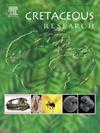松辽盆地下白垩统沙河子组碎屑锆石物源:LA-ICP-MS U-Pb年代学的启示
IF 1.7
3区 地球科学
Q1 GEOLOGY
引用次数: 0
摘要
松辽盆地位于中国东北部,是东亚最大的大陆裂谷盆地之一。它保存了几乎完整的白垩纪大陆沉积记录,为白垩纪时期陆地系统的古气候、地球动力学和构造过程提供了见解。下白垩统沙河子组沉积于松辽盆地同裂谷期,为一层厚的陆相碎屑沉积。但对沙河子组沉积时期的物源及构造背景尚不清楚。本研究利用松辽盆地国际大陆钻探项目SK-2钻孔收集的沙河子组6个砂岩样品的碎屑锆石U-Pb年代学研究。锆石年龄分布显示出3个主要的年龄群:~ 128 ~ 113 Ma、~ 184 ~ 159 Ma和~ 247 ~ 216 Ma,表明原始沉积源在沉积过程中保持稳定。这些结果表明,大兴安岭北部是一个重要的沉积源,约在118 ~ 113 Ma形成了沙河子组。本文章由计算机程序翻译,如有差异,请以英文原文为准。
Detrital zircon provenance of the Lower Cretaceous Shahezi Formation in the Songliao Basin, Northeast China: Insights from LA-ICP-MS U-Pb geochronology
The Songliao Basin, located in northeastern China, is one of the largest continental rift basins in East Asia. It preserves a nearly complete record of Cretaceous continental sedimentary records, providing insights into paleoclimatic, geodynamical, and tectonic processes in terrestrial systems during the Cretaceous Period. The Lower Cretaceous Shahezi Formation, deposited during the syn-rift stage of the Songliao Basin, consists of thick sequences of terrestrial clastic sediments. However, the provenance of the sediments and tectonic background during the deposition of the Shahezi Formation remain poorly understood. This study utilises U–Pb geochronology of detrital zircons from six sandstone samples collected from the Shahezi Formation as part of the International Continental Drilling Project SK-2 borehole in the Songliao Basin. The zircon age distributions reveal three dominant age clusters: ∼128–113 Ma, ∼184–159 Ma, and ∼247–216 Ma, indicating that the primary sediment source remained stable throughout deposition. These results suggest that the northern Great Xing’an Range was a significant sediment source, contributing to the Shahezi Formation at approximately 118–113 Ma.
求助全文
通过发布文献求助,成功后即可免费获取论文全文。
去求助
来源期刊

Cretaceous Research
地学-地质学
CiteScore
4.10
自引率
19.00%
发文量
235
审稿时长
12 weeks
期刊介绍:
Cretaceous Research provides a forum for the rapid publication of research on all aspects of the Cretaceous Period, including its boundaries with the Jurassic and Palaeogene. Authoritative papers reporting detailed investigations of Cretaceous stratigraphy and palaeontology, studies of regional geology, and reviews of recently published books are complemented by short communications of significant new findings.
Papers submitted to Cretaceous Research should place the research in a broad context, with emphasis placed towards our better understanding of the Cretaceous, that are therefore of interest to the diverse, international readership of the journal. Full length papers that focus solely on a local theme or area will not be accepted for publication; authors of short communications are encouraged to discuss how their findings are of relevance to the Cretaceous on a broad scale.
Research Areas include:
• Regional geology
• Stratigraphy and palaeontology
• Palaeobiology
• Palaeobiogeography
• Palaeoceanography
• Palaeoclimatology
• Evolutionary Palaeoecology
• Geochronology
• Global events.
 求助内容:
求助内容: 应助结果提醒方式:
应助结果提醒方式:


